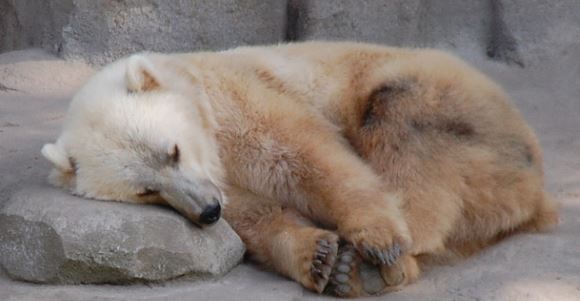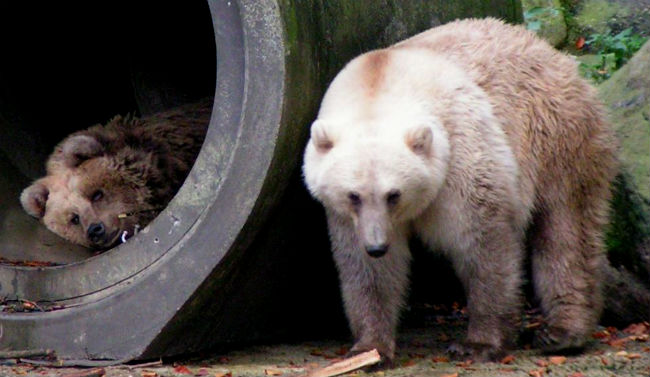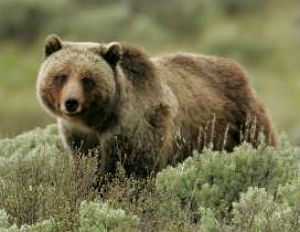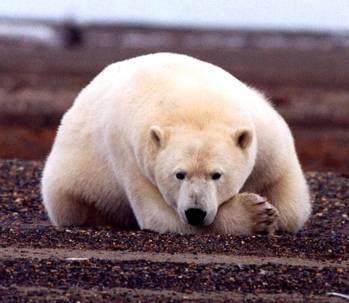Polar Bear/Brown Bear Hybrids
|
|
EUGENE M. MCCARTHY, PHD GENETICS
There is extensive parapatric contact between these bears in northern North America and northern Eurasia. Hybrids, which are partially fertile in both sexes, occur naturally, and innumerable hybrids have been produced in captivity as well. They are known as pizzly bears, pizzlies, grolar bears, polargrizzes, or nanulaks. The last name combines the Inuit words nanuk (polar bear) and aklak (brown bear). They swim better than brown bears, but not so well as polar bears.
These hybrids were formerly very common in zoos. Today most zoos try to prevent hybridization, but twin hybrids (dubbed “Tips” and “Taps”) were born in the Osnabrück Zoo (Germany) in Jan. 2004. The National Zoological Park in Washington, D.C. reported F₂ hybrids (International Zoo Yearbook 1962, p. 229). A backcross to polar bear was almost identical to polar bear, except for very light brown shading along the back. Hybrids between the polar bear and the brown bear are white at birth, but take on a yellowish-white or blue-brown coloration as they mature (Gray 1972). This cross is reversible, but a brown bear is usually the mother.
 A polar bear/brown bear hybrid at Osnabrück Zoo, Germany.
A polar bear/brown bear hybrid at Osnabrück Zoo, Germany.Image: Stefan David (License)
A bear shot in Northwest Territory, Canada (Banks Island), by hunter Jim Martell in 2006, was genetically verified by the territory’s Department of Environment and Natural Resources as a hybrid of this type. Its mother was a polar bear. It had the thick white fur of a polar bear, but the long claws, humped back, and concave face of a grizzly. Its eyes were ringed with dark fur like a panda’s. There were small brown patches, too, on the nose, back, and a single paw. A similar case of natural hybridization was documented in 2010, however, this time the animal was a second-generation cross; its mother was a hybrid, and its father, a grizzly (Kelly et al. 2010).
 Polar bear/brown bear hybrids at Osnabrück Zoo, Germany.
Polar bear/brown bear hybrids at Osnabrück Zoo, Germany.Image: Wikimedia, Corradox (License)
Such hybridization may well have been occurring for some time and simply not have been recognized due to the remote locales in which it occurs. The Smithsonian has a probable natural hybrid shot in the 1800s. Described as a species (Vetularctos inopinatus Merriam, 1918), it was shot in 1864 at Rendezvous Lake, Barren Grounds, northern Canada. The specimen is buff white with a golden brown muzzle. Hagenbeck (1909, p. 117) said one such hybrid that he saw at a zoo was piebald, “his fur being half greyish-brown and half white.”
Barnes et al. (2002) found that the mtDNA of some brown bears is more similar to that of polar bears than to that of other brown bears, which strongly suggests that these so-called brown bears are descended from polar bear ancestors on the mother’s side. Indeed, in a genetic study, Edwards et al. (2011) concluded that extensive natural hybridization of this type has been taking place for thousands of years. They say “opportunistic mating between these two species as their ranges overlapped has left a strong genetic imprint. In particular, a likely genetic exchange with extinct Irish brown bears forms the origin of the modern polar bear matriline. This suggests that interspecific hybridization not only may be more common than previously considered but may be a mechanism by which species deal with marginal habitats during periods of environmental deterioration.
By the same author: Handbook of Avian Hybrids of the World, Oxford University Press (2006).
References:
Ackermann 1898 (p. 47); Antonius 1951b; Benirschke 1967; Craighead 2000 (p. 13); Davis 1950; Gray 1972; International Zoo Yearbook 1959 (p. 143), 1960 (p. 260), 1961 (p. 262), 1962 (p. 229), 1965 (p. 338), 1966 (p. 394), 1967 (p. 311), 1968 (p. 300), 1969 (p. 228), 1970 (p. 262), 1971 (p. 274), 1972 (p. 327), 1974 (p. 380), 1975 (p. 373), 1980 (p. 433), 1981 (p. 319), 1982 (p. 422), 1990 (p. 457); Kowalska 1962†, 1965†, 1969; Mann 1938; Martin 1873, 1876, 1877, 1878, 1882; Merriam 1918; Przibram 1910; Roach 2006; Rörig 1903; Scherren 1907; Wurster-Hill and Bush 1980.

